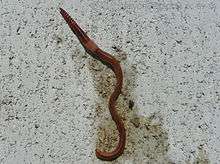European nightcrawler
| Eisenia hortensis | |
|---|---|
 | |
| Scientific classification | |
| Kingdom: | Animalia |
| Phylum: | Annelida |
| Class: | Clitellata |
| Order: | Haplotaxida |
| Family: | Lumbricidae |
| Genus: | Eisenia |
| Species: | E. hortensis |
| Binomial name | |
| Eisenia hortensis (Michaelsen, 1890) | |
The European nightcrawler, Eisenia hortensis or Dendrobaena veneta, is a medium-small earthworm averaging about 1.5 grams each when fully grown. Generally blueish, pink-grey (cf. Latin veneta meaning "sea-blue") in color with a banded or striped appearance. The tip of the tail is often cream or pale yellow. When the species has not been feeding, it is pale pink. The species is usually found in deep woodland litter and garden soils that are rich in organic matter in European countries. Eisenia hortensis is sold primarily as a bait worm, but its popularity as a composting worm is increasing.[1]
Etymology
The genus Eisenia is named after Swedish scientist Gustav Eisen. According to the International Code of Zoological Nomenclature, the adjectival hortensis ("of the garden") is put after the genus name; it is derived from Latin hortus meaning "garden".
Usage
Compared to E. fetida, E. hortensis does best in an environment with a higher carbon to nitrogen ratio. This makes it well suited to compost pits high in fibrous materials commonly known as browns.[2] European nightcrawlers can be invasive and should be used only in contained compost systems in parts of the world with northern deciduous and boreal forest ecosystems.[3]
Reproduction
Eisenia hortensis is a hermaphrodite, it has both male and female reproductive organs. In mating, the less strong partner is forced in to the female role which is more 'expensive' in terms of biological reproduction-costs, for a sperm cell is generally less massive and energy demanding than an ovum ("egg cell"), which is the female reproductive cell (gamete) in anisogamous organisms. Two worms join clitella, the large lighter-colored bands which contain the worms' reproductive organs, and which are only prominent during the reproduction process. The two worms exchange sperm. Both worms may secrete cocoons which contain an egg each. These cocoons are lemon-shaped and are pale yellow at first, becoming more brownish as the worms inside become mature. These cocoons are clearly visible to the naked eye.
- Statistics
- From egg to sexual maturity ~ 20 weeks
- Net reproduction of c. 0.8 eggs per adult per week
- Egg cells are oviposited in a cocoon
- One E. hortensis embryo per egg per cocoon
References
- ↑ "Red wiggler versus the european nightcrawler, Part 2". wormsetc.com. 16 December 2010.
- ↑ "Eisenia fetida, or hortensis? Whats the difference? Red wigglers or European nightcrawlers? Part 1". wormsetc.com. 3 December 2010.
- ↑ "Do Composting Worms Pose a Threat as Invasive Species? - Red Worm Composting". www.redwormcomposting.com.